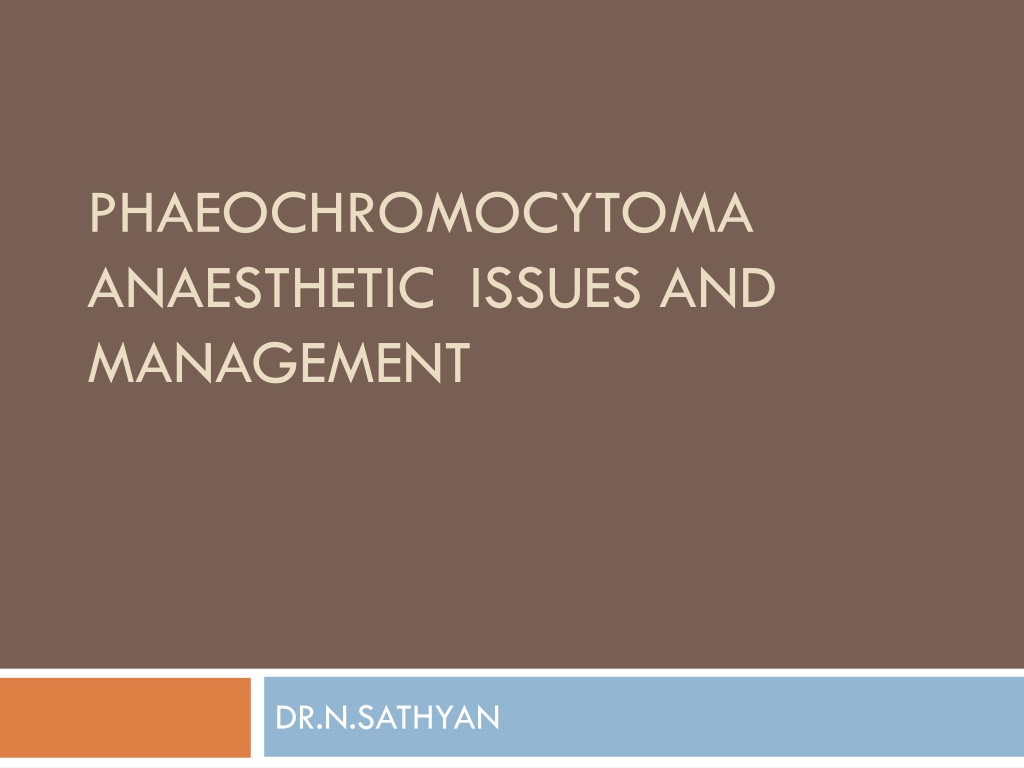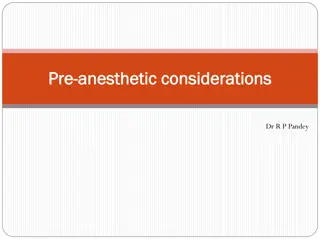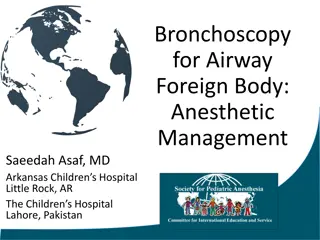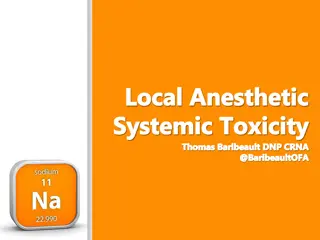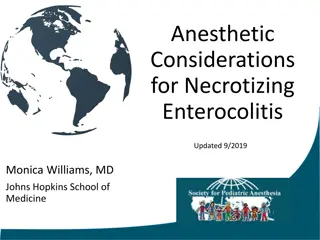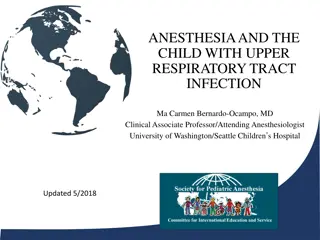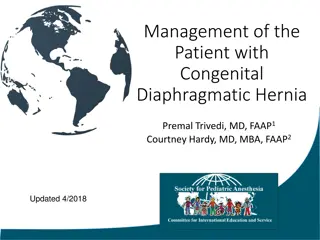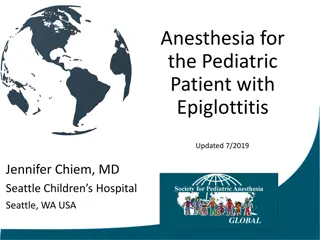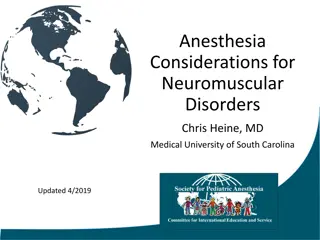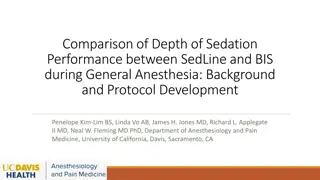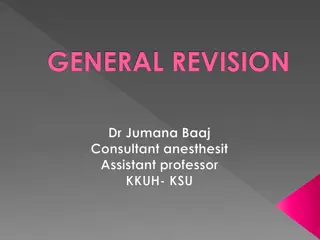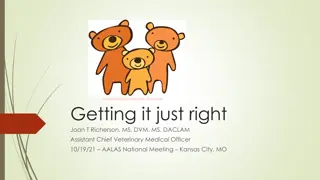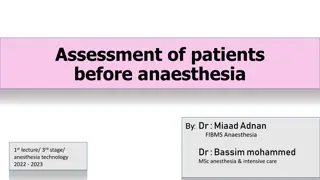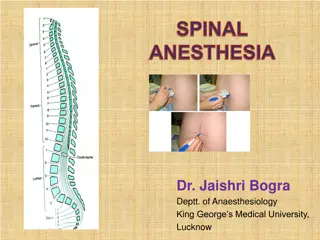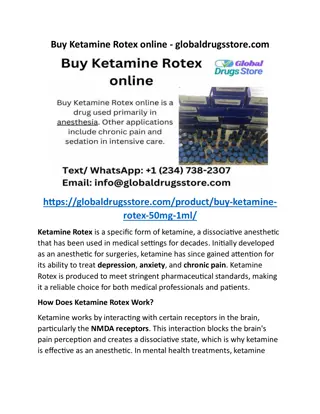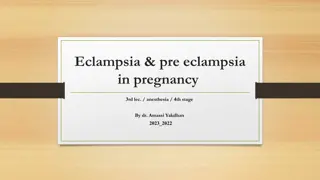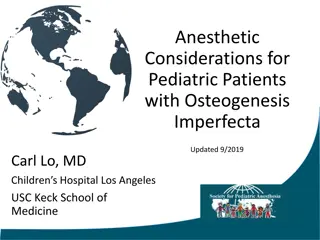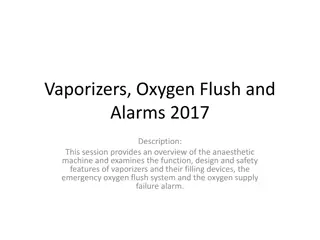Anesthetic Management of Phaeochromocytoma: Key Issues and Strategies
Phaeochromocytoma, a neuroendocrine tumor of the adrenal medulla, presents unique challenges in anesthesia due to excessive catecholamine secretion. From clinical presentation to familial associations, this condition requires careful diagnosis and management to avoid complications during surgery. Understanding the origin, metabolism, and rule of 10 in dealing with these tumors is crucial for successful outcomes. Various familial syndromes link phaeochromocytoma to other conditions, emphasizing the importance of thorough evaluation and interdisciplinary care.
- Anesthetic management
- Phaeochromocytoma
- Catecholamine excess
- Neuroendocrine tumors
- Familial syndromes
Download Presentation

Please find below an Image/Link to download the presentation.
The content on the website is provided AS IS for your information and personal use only. It may not be sold, licensed, or shared on other websites without obtaining consent from the author. Download presentation by click this link. If you encounter any issues during the download, it is possible that the publisher has removed the file from their server.
E N D
Presentation Transcript
PHAEOCHROMOCYTOMA ANAESTHETIC ISSUES AND MANAGEMENT DR.N.SATHYAN
Objectives Clinical Presentation Diagnosis Management
Introduction Neuroendocrine Tumor of the Adrenal Medulla cells sympathetic chain Chromaffin along the paravertebral Phaeo dusky ., chromo coloured History Von Frankel, Pick, Roux & Mayo excessive Noradrenaline & Dopamine Secretes amounts of Adrenaline,
Tumors Producing Catecholamine Excess Phaeochromocytoma Sporadic ( Norepi > Epi ) vs Familial ( Epi > Nor) Large (more metabolite) catecholamines) Paraganglioma - Norepi Malignant Phaeo - Dopamine, HVA Ganglioneuroma Norepi Neuroblastoma Dopamine, HVA Chemodectoma & Glomus jugulare - Norepi vs Small ( more
RULE OF 10 EXTRA ADRENAL ( Close to 15 %) CHILDREN FAMILIAL ( 20%) BILATERAL OR MULTIPLE (Familial) RECUR (extra adrenal) MALIGNANT INCIDENTALOMA
Familial Phaeochromocytoma MEN 2a 50% Pheo (usually bilateral)+ medullary Ca Thyroid + hyperparathyroidism MEN 2b 50% Pheo (usually bilatl) mucosal neuroma, marfanoid habitus Von Hippel-Landau 50% Pheo (usually bilat), retinoblastoma, cerebellar hemangioma, nephroma, renal/pancreas cysts
Familial Phaeochromocytoma NF1 (Von Recklinghausen's) 2% Pheo (50% if NF-1 and HTN) Caf -au-lait spots, neurofibroma, optic glioma Familial paraganglioma Familial pheo & islet cell tumor Others: 1. Tuberous sclerosis, 2. Sturge-Weber, 3. Ataxia-telangectgasia, 4. Carney s Triad chondroma) (Pheo, Gastric Leiomyoma, Pulm
Clinical Presentation M = F ; 0.01% of HT ; 3rd-5thdecade Suspect : severe HTN, HTN crisis, refractory HTN, young age HTN, incidental imaging Symptoms : pain (headache) , perspiration, palpitation Signs : Hypertension (pressures) , pallor Paroxysms or episodic 10-60 min; daily monthly ; spontaneous / precipitated (procedures, drugs, movements)
CVS Effects Sinus ectopics, VF Systolic HTN, diastolic hypotension (epi) Angina / MI / coronary vasospasm (catecholamine induced increased oxygen consumption) Hypertrophic cardiomyopathy diastolic dysfunction (nor) Dilated cardiomyopathy systolic dysfunction (epi) Concentric / asymmetrical hypertrophy Myocarditis CCF Polycythemia and orthostatic hypotension ( ecf contraction, loss of postural reflexes, release of adrenomedullin ) Sinus node dysfunction tachycardia (epi), bradycardia (nor),SVT, Vent
CNS Effects Panic attacks, apprehension, sense of impending doom encephalopathy status, focal signs, seizures) Hypertensive (altered mental Stroke , intracerebral bleed
Metabolic effects Nausea & vomitting dopamine induced GI vasodilatation Glucose intolerance dec insulin, glycogenolysis (nor), Hypercalcemia Men 2 HPT Polyuria Lipolysis - Weight loss
Diagnosis Biochemical Localization 24 hrs Ur. Catecholamine 24 hrs Ur. Tot metanephrines 24 hrs Ur. catechol + metanep 24 hrs Ur. VMA HPLC ; Positive > 2-3 fold elev Plasma free Catecholamine (>2000 pg/ml) Plasma free Metanephrine False Positive : drugs (tca,maoi,levodopa,methyldopa,l abetalol,clonidine,illicit drugs,ethanol,diuretics,sympatho mimetics); physical stress (hypoglycemia,stroke), smoking Adrenal (90%) & extra adrenal sites (organ of zuckerkandl, bladder, myocardium, mediastinum) CT Abdomen adrenal pheo MRI extra adrenal phaeo MIBG Scan I 123/I 131 labelled tumor not visible CT/MRI Inject mibg & scan @ 24,48,72,hrs False negative labetalol,reserpine,tca,phenothiaz ines- w/h 4-6 weeks
Biochemical Tests : Summary SENSITIVITY SPECIFICITY U catechols 83% 76% 90% 63% 85% 99% 88% 94% 98% 94% 80% 89% U total metanephrines U catechols+metaneph U VMA Plasma catecholamines Plasma metanephrines
Suppression / Stimulation tests Clonidine suppression test Usually they decrease catecholamines Unlike normals, pheo patients won t suppress their plasma norepi with clonidine Glucagon stimulation test May precipitate hypertensive crisis Pheo patients, but not normals, will have a > 3x increase in plasma norepi with glucagon
Anaesthetic Management Mortality 25-50% vs 0-3%; Preparation/newer techniques / team approach Preoperative preparation Intraoperative management Post operative care
Anaesthetic Consideration Preoperative optimisation Alpha & Beta blockade Restore intravascular volume Haemodynamic lability and crisis End organ Dysfunction Associated conditions Postoperative complications
Preparation Regimes Combined and blockade (start 10-14 days preop) Phenoxybenzamine Selective 1 blockers (prazosin, doxazosin, terrazosin) Propranolol, atenolol, esmolol Labetalol Metyrosine Calcium channel blockers Nicardipine Diltiazem ACEI / ARB
Phenoxybenzamine DOC / Covalently binds -receptors ( 1 > 2) Start 10 mg po bid ; increase q2d by 10-20 mg/d Increase until BP control and no more paroxysms Maintenance 40-80 mg/d (some need > 200 mg/d) Clinical indicator : nasal stuffiness, postural hypotension Side-effect: orthostasis with dosage required to normalize seated BP, reflex tachycardia Causes presynaptic inhibition of adrenergic control thus leading to increase in beta adrenergic outflow, Thus beta blockers needed to be given alongside Drawback: periop hypotension/shock unlikely to respond to pressor agents. Roizens criteria : Arterial BP < 160/95 mm Hg in the last 48 hrs prior to surgery,recommended to measure in stressful environment ; Mild orthostatic hypotension indicates optimal adrenergic blockade but not < 80/45; ECG - free of ST changes for > 2 wks; Ventricular ectopic < 1 over 5 min
Beta Blockers Start only after effective -blockade (may ppt HTN) Used to control reflex tachycardia and prophylaxis against arrhythmia during surgery If suspect CHF/dilated CMY ; start low dose Propranolol : Start 40 mg po bid ; increase to control HR Up to 480 mg/day in divided doses IV 1-2 mg bolus Side effects- may induce cardiac failure, bronchospasm Oral bioavailability 25% (extensive 1st pass metabolism) Atenolol - selective 1 Dose 50- 100 mg/d PO ; Max 300 mg/d; IV 2.5 to 10 mg/d Esmolol selective 1 for rapid intraop BP control ; Bolus IV 250-500 /kg/min; Infusion 25 to 250 /kg/min Labetolol mixed + Dose- 50- 200 mg/d PO ; IV 0.25 mg/kg ; Not used as a sole drug due to unpredictable control of BP
Alpha Blockers If BP still not control despite + blockade, Add Prazosin to Phenoxybenzamine Prazosin (Minipress) competitive, selective 1 blockade T1/2 : 2-3 Hrs; Dose : 1-5 mg PO BD; Side effects- postural hypotension reflex tachycardia;No blockade required; Not routinely used as incomplete a-blockade; Used more for long-term Rx (inoperable or malignant pheo) Other selective 1 blockers- terazosin, doxazocin
CCB Diltiazem 60 - 120mg/d, max 360mg/d ; T1/2 : 3 to 5 hrs; Side effects - bradycardia, exacerbates cardiac failure Nifedepine 30mg/d PO Max. 360mg/d; T1/2 : 1 to 2 hrs; Side effects- hypotension, peripheral edema Nicardipine Started po 24h to few weeks preop to cntrl BP and allow ECF restoration; After intubation IV Nicardipine gtt (start 2.5 ug/kg/min); IV Nicardipine adjusted to SBP ; Stopped prior to ligation of tumor venous drainage; Tachycardia Rx with concurrent IV esmolol Advantage : decrease severity of vasospasm periop hypotension may still respond to pressor agents as opposed to those patients who are completely alpha-blocked No reflex tachycardia
Metyrosine Synthetic inhibitor of Tyrosine Hydroxylase (TH) Start 250 mg qid ; max 1 gm qid S/E : sedation, extrapyramidal, diarrhoea, nausea, vomitting , anxiety, renal /gb stones, galactorrhea Alone may insufficiently control BP and reported HTN crises during pheo operation Restrict use to inoperable/malignant pheo or as adjunct to + blockade or other preop prep
Volume Expansion Increased fluid intake : 2-3 L Increase Salt intake : 5-10 Gm IV Crystalloids / Colloids Serial Haematocrit measurement 5 10 % fall in Hct
Investigations CBC Sugar, urea, creatinine, electrolytes BT,CT,PT,INR,PTT X-ray chest Electrocardiogram Echocardiogram
Premedications Admit night before for overnight IV saline Anxiolytic sedative- benzodiazepine helps dec catecholamines release Opioids- morphine preferably avoided as causes histamine release; Fentanyl, sufentanyl safe Atropine or Glyco pyrolate to be omitted- causes tachycardia Droperidol- antiemetic, adrenoceptor and inhibit catecholamine uptake & promotes catecholamine release blocks alpha 2
Check Availability Meds given on morning of surgery Periop HTN : IV Phentolamine (Regitine) , short acting non-selective alpha-blocker IV Nitroprusside (NTP) / IV Nitroglycerine IV Esmolol / IV Labetalol IV Magnesium Sulphate Periop Arrhythmia: IV Esmolol Inotropic Supports : Dobutamine / Milrinone Periop Hypotension: IV crystalloid +/- colloid Dopamine / Norepinephrine / phenylephrine vasopressin
Monitors & Lines ECG, Saturation, NIBP, EtCO2, RR, Temp, Urine output Arterial line CVP Pulmonary Artery catheter (low EF) TEE 2 large bore IV peripheral lines
Anaesthesia Technique General Anaesthesia Combined General and Regional anaesthesia GA + EPIDURAL preferred Induction Thiopentone /Propofol/Etomidate BZD + Opioids + Induction agents Pressor response attenuation Laryngoscopy & Intubation catecholamine levels increase normal 200-2000 pg/ml vs phaeo 2000 20000 pg/ml Xylocard : 1.5 mg/kg Esmolol : 50-100 mcg /kg Neuromuscular blockers cardiostable & least histamine release Vecuronium / rocuronium / cisatracurium Suxa / atra /miva avoided Maintainance : Isoflurane / sevoflurane
Problems Large tumors/ increased duration of Sx / increased preop catecholamines HTN crisis Laryngoscopy, intubation, positioning, skin incision, peritoneal insufflation, surgical stimulation, tumor handling IV NTP, Phentolamine, NTG, Esmolol, nicardipine MgSO4 , 40 - 60 mg/kg bolus followed by 2gm/hr infusion Sudden Hypotension Ligation of the venous drainage Crystalloid / colloids, CVP 12 Dopamine/ Noradrenaline / Phenylephrine Vasopressin / Methylene blue
Post OP Hypovolemia Hypertension Hypoglycemia Hyponatremia Hypoadrenalism ICU care Surveilance & Follow up
Laparoscopic Sx Adrenal mass < 6 cms dia < 100 gms weight Slow CO2 insufflation Pressure < 12 mm Hg Positioning
Unresectable, Malignant -blockade Selective a1-blockers (Prazosin, Terazosin, Doxazosin) 1stline as less side-effects Phenoxybenzamine: more complete alpha blockade -blocker CCB, ACE-I, etc. Nuclear Medicine Rx: Hi dose 131I-MIBG depending on MIBG scan or octreoscan pick-up Sensitize tumor with Carboplatin + 5-FU or 111indium-octreotide
Phaeochromocytoma in Pregnancy Grave prognosis , mortality: maternal - 48%, fetal 55% Diagnosis with 24h urine collections and MRI No stimulation tests, no MIBG if pregnant Do not Allow labour 1st & 2nd trimester (< 24 weeks): Phenoxybenzamine + beta blocker prep Resect tumor laprascopically or open 3rd trimester: Phenoxybenzamine + blocker prep ..2-3 wks When 37 weeks: caesarian section followed by tumor resection
Conclusion Good pre op preparation Vigilant intra op monitoring Intense post op care Experienced coordinated Team
